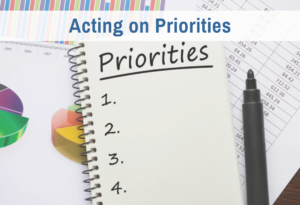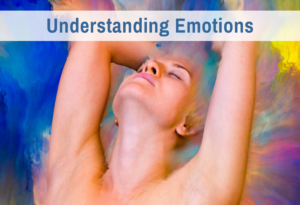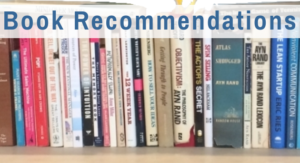In the most recent article in this series on happiness, I mentioned that the next topic would be embracing causality. To be happy, you need to understand the causal factors that contribute to your present emotional state so that you can enact the causes that will create your future happiness. First and foremost, this means understanding the causal nature of emotions.
Unfortunately, emotions are widely misunderstood. In this article, I will start with the basics: what emotions are and their obvious characteristics. Then I’ll make a case for how to think about them with respect to happiness.
An emotion-filled scenario
To begin, we need a range of examples of emotions. Consider this scenario with three people having a conversation:
The first person, call him Talker, has held the floor for ten continuous minutes. He is explaining his pet theory about what will happen in the next election. He is animated and gesturing frequently. The second person, call him Listener, is finding it a bit difficult to follow. He’s a little overloaded by all that Talker is saying, but trying hard to make sense of it. You can see the concentration on his face. He’s starting to feel a little tired. The third person, call him Interrupter, is looking tense. He’s been making gestures of disagreement after some of Talker’s points. At the end of the ten minutes, he interrupts and asks Talker to pause so that he and Listener “can get a word in edgewise.” Listener nods and pipes in with a question that shows he hasn’t followed much of what Talker has been saying.
Common sense would tell us that these three people feel very different emotions before and after the interruption. For the purposes of this article, let’s stipulate that they feel the following:
Talker instantly feels anger at Interrupter. He thought the interruption was rude. He had been feeling pride in his logic, confidence in his ability to convince one and all, and sheer joy at expounding his views. At the moment of interruption, his first emotions are fear that he will lose his train of thought and frustration that Interrupter is interfering. When he hears Listener’s question, his joy turns to grief. He had not succeeded in communicating his views.
Listener feels relief at the interruption. He can stop the struggle to understand by himself. He is eager to ask his question, and he feels hope that the answer will clarify his confusion. In the background, he feels some gratitude toward Interrupter for giving him the opportunity to ask his question. In hindsight, he had felt a growing frustration as he tried to understand the flow of words from Talker, and a fear that Talker wouldn’t stop.
Interrupter had been feeling a growing aversion to listening to more words from Talker. He had heard this theory before, and he felt resentment at Talker’s apparent indifference to his gestures of disagreement. He felt desire for Talker to stop so that he could challenge the ideas, but as the minutes dragged on, this feeling was tinged with despair. It seemed as if Talker would never stop on his own accord. Interrupter started feeling a desire to interrupt, but that made him feel guilt, because his mother taught him it is always rude to interrupt. As time went on, the intensity of desire, despair, resentment, and guilt coalesced into anger at Talker for “putting him in this uncomfortable position.” He felt a strong desire to interrupt, which he fought for a while, which increased the tension he felt. Finally, he gave in to the impulse. Once he has interrupted, his feelings change. He feels relief for having released the tension and guilt for having done so ungraciously. When he observes Talker’s anger with him, he feels sad that this political discussion is affecting their friendship. He thinks of their past camaraderie and feels a longing for what had been. As he thinks more about their past, he feels his dormant affection for Talker rise to the surface.
The variety of emotions
Let’s sum up the examples of emotions in this scenario for quick reference:
Anger
- Talker felt anger at Interrupter for his rudeness.
- Interrupter felt anger at Talker for his “putting him in this position.”
- Interrupter felt resentment at Talker for his “apparent indifference to disagreement.”
Gratitude
- Listener felt gratitude toward Interrupter for making an opening for his question.
Fear
- Talker felt fear he would lose his train of thought.
- Both Listener and Interrupter felt fear that Talker wouldn’t stop.
Relief
- Listener felt relief at being able to stop struggling to understand.
- Interrupter felt relief after releasing his tension by acting on the impulse.
Despair
- Interrupter felt despair about the possibility of Talker pausing.
Hope
- Listener felt hope at the possibility that his confusion could be cleared up.
Guilt
- Interrupter felt guilt at the thought of interrupting.
- Interrupter felt guilt for having been ungracious in his interruption.
Pride
- Talker felt pride for his own eloquence.
Frustration
- Listener felt frustration at his inablity to follow the argument.
- Talker felt frustration at not being able to continue talking.
Confidence
- Talker felt confidence at his ability to make his argument clearly.
Joy
- Talker felt joy when he believed he expressed himself well.
Grief
- Talker felt grief when he realized that contrary to his belief, he had not expressed himself well.
- Interrupter felt grief when he realized that he had lost camaraderie with Talker.
Love
- Interrupter felt affection for Talker.
Indifference
- Talker allegedly felt indifference toward Interrupter’s disagreement.
Desire
- Interrupter felt a desire for Talker to stop.
- Interrupter felt a desire to interrupt.
- Interrupter felt a longing for his past camaraderie with Talker.
Aversion
- Interrupter felt an aversion to listening to more words from Talker.
Emotions vs. Mental-Physical States
If you look carefully at the scenario, you will see that I did not include certain feelings in my list of emotions: Tiredness, tension, overload. These feelings are states of the organism. As I mentioned in the first article in the series, some feelings are direct readouts on the state of mind (overload) and body (tiredness and tension). All bodily sensations of pleasure and pain are this kind of feeling, i.e., they are states of mind and body, not emotions.
Both kinds of feelings involve affect (pleasure and pain), and therefore contribute to happiness or suffering. Both kinds of feelings have motivational aspects — they foster action or inaction. Both draw the attention to something. But emotions and the objects of emotions are special. Emotions are a product of stored (subconscious) content — images, memories, ideas. In the same vein, the object of an emotion is not some aspect of the mind or body, but some object of awareness, something you are already conscious of. Because we are conceptual beings, it is per se a conceptually grasped object. As adults, we cannot focus on anything without identifying it conceptually. This is what makes emotions so amazingly complex.
If you look at the examples of emotions above, you will see a range in complexity of the objects of emotions. In simple cases, the object of the emotion is literally an entity in the world — such as a person. Listener felt gratitude toward Interrupter. Talker and Interrupter felt anger toward each other. You can feel fear toward a dog, or a plane, or a gun. But even when the object is simple, we grasp it conceptually — we activate a conceptual understanding of that object. Indeed, you would not feel fear of a dog, plane, or gun without having conclusions in the past that they posed a threat to you in some way.
In the other examples, the objects of emotions are much more complex. Many emotions are responses to thoughts about the situation such as a prediction of the future or an evaluation of oneself. Consider Interrupter’s guilt at the thought of interrupting or Listener’s hope at the possibility that his confusion could be cleared up or Talker’s short-lived pride in his own eloquence. Or for example, consider Interrupter’s resentment at Talker’s apparent indifference to his disagreement. You can have emotions in response to your speculations!
Anything you can think about, you can have an emotion about. As your thinking about something changes, your emotions change, as did Talker’s when his joy and pride in his ability to express himself turned to grief when he realized it was an illusion.
You can even have emotions about other feelings. Have you ever been frustrated that you were tired, because you wanted to keep working? Or embarrassed that you were angry, because you thought it was an inappropriate response?
The two basic objects of emotions: values and threats
Recognizing the conceptual nature of the emotions is critical to thinking about them.
People often think that the basic distinction between emotions is whether they are positive or negative. In common sense, this means they signal good news or bad news. On this categorization, most people would divide the emotions listed above as follows:
Positive: Gratitude, Relief, Hope, Pride, Confidence, Joy, Love, Desire
Negative: Anger, Fear, Despair, Guilt, Frustration, Grief, Indifference, Aversion
Essentially, “good news” emotions are accompanied by pleasurable affect and “bad news” ones by painful affect. But emotions can be complex, and the affect involved can be influenced by other factors. Anger sometimes feels energizing, which is pleasurable. Desire can feel pleasurable when it’s eagerness and painful when it’s longing — because it’s tinged with hopelessness.
This is an obvious categorization, but not a particularly helpful one. Of course you want more good news than bad news in your life. But the question is, how do you act to ensure you keep getting good news instead of bad?
It is much more fundamental — and useful — to categorize emotions on the basis of type of object. In the examples above, there are two kinds of objects — values and threats.
Value-oriented: Gratitude, Pride, Confidence, Joy, Love, Desire…and indifference and grief
Threat-oriented: Anger, Fear, Despair, Guilt, Frustration, Aversion…and relief and hope
The value-oriented emotions draw your attention to the values, such as the helpful person, one’s skill, one’s anticipated success, one’s friend, the anticipated benefits.
In contrast, the threat-oriented emotions draw your attention to threats, i.e., an interruption, a loss of train of thought, a continuing struggle to understand, a violation of your own standards, a continuation of an unpleasant situation.
Note in particular that two “good news” emotions, hope and relief, are threat-oriented. Relief is the emotion you feel when a threat has been removed. Hope is the emotion you feel when you are surrounded by threats, and see maybe a small channel of escape. You will feel better than you did, when fear turns to relief and despair hope. But your enduring happiness requires that you see the values in the world around you, and neither of these emotions is focused on values.
Similarly, grief and indifference are “bad news” emotions. But as we saw in the case of mourning, when you turn your attention to values lost, you quickly start strengthening the values, and seeing ways to gain them in your new circumstances. Indifference is an interesting case because it is neutral. I think it is best understood as looking around, and the values are too small to matter. The natural response to this is to look elsewhere to find the values — not to look around for threats.
The immediate causal consequences of emotions
Thinking about emotions in terms of the type of object is helpful, because the effect of an emotion is to draw its object closer to focal awareness.
What does this mean? It means that you will necessarily pay more attention to the object than you would have before feeling the emotion.
This has automatic, immediate consequences. Because you are paying attention to it, any related content in the subconscious — past experiences, rules or principles, words, people, places, things — will be increasingly activated. Having an emotion literally activates a related context of knowledge, at least to some degree.
If it’s a value-oriented emotion, more information about that value will be activated. If it’s a threat-oriented emotion, more information about that threat will be activated.
This is why emotions sometimes spiral out of control. You feel despair, this triggers memories of similar experiences of despair, suddenly that’s all you can think about and the despair is ten times worse. You just want to curl up into a little ball! Or perhaps you imagine how wonderful it would be if someone returned your romantic regard, and the joy and love that triggers in turn brings up other potential joys. Before you know it, you are living in a beatific daydream, having lost touch with the real world.
This is also why mourning for a loved one involves so much bittersweet love and laughter. Grief turns your attention to the person you lost. As you think about them, you start remembering the good times. In contrast, if you are focused on fear about what your life will be like without them, that will trigger lots of ideas about the bad things that will happen or be difficult in the future. This can quickly lead to despair and depression.
This is also why relief and hope are so often short-lived. Listener felt relief and hope after asking his question. He had a brief respite from struggle and hoped Talker could sort it out for him. But notice that both of these emotions are passive emotions. They do not motivate action to get that clarity — rather they turn his attention to the fact he is not struggling. This is not going to motivate the work to understand. So what happens when Talker doesn’t answer the question or Interrupter diverts the issue, rather than stopping everything to help sort out Listener’s confusion? Listener will start feeling like a victim. He’ll be angry at them, frustrated, etc.
In contrast, pride and confidence are value-oriented active emotions. If you are listening to something that you can’t follow, and you deliberately hold the context of your knowledge and skill, the ensuing pride and confidence will spur you to interrupt and ask your question more gracefully — sooner — or to excuse yourself and go think about it by yourself. Or think about something else that is more important to you.
As I have discussed in a recent article, the key to happiness is to maintain a value orientation. It is critical that you don’t confuse this with “having positive emotions.” It is not the same thing at all!
As I discussed in that article, the fact that you feel threat-oriented emotion is not a problem. Indeed, it is helpful information. A threat is a threat to a value. It takes only a couple of thinking steps to figure out what that value is. This is what lets you look at the entire situation from a value orientation.
The bottom line: if you want to be happy, it helps to think about emotions in terms of whether they are value-oriented or threat-oriented. Thinking about emotions this way helps you make causal predictions about the future — and therefore whether you need to intervene to change the default course of events. You are, after all, the most potent causal factor in your happiness. This will be the topic of the next article.









0 Comments